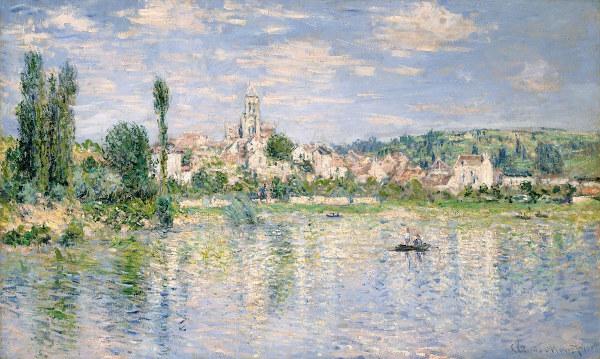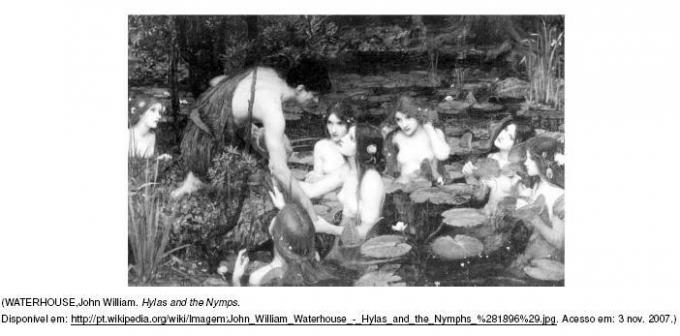William Shakespeare was born on April 23, 1564, in Stratford-upon-Avon, England. Later, in London, he was successful as a poet and, mainly, as a playwright. Thus, his works can be inserted into four distinct phases, so that:
the first phase has character humanist and texts belonging to the epic genre and lyrical;
the second is composed of historical plays and light comedies;
the third presents the author's famous tragedies;
the fourth, and last, is composed of tragicomedies with mild themes.
Thus, the writer, who died on April 23, 1616, in Stratford, left great theatrical works, such as Romeo and Juliet, Hamlet, Macbeth, king lear and Othello.
Read too: Dramatic genre - texts written with the aim of being staged
William Shakespeare Biography

William Shakespeare was born in April 1564 in England. His baptism took place on April 26, 1564, in the Church of the Holy Trinity in Stratford-upon-Avon, or simply Stratford. Some scholars claim that the day of his birth, therefore, was April 23, since at the time it was customary to baptize children three days after they were born.
His father was John Shakespeare (1531-1601), who had great importance as a businessman and public person, as he became a councilor and bailiff of Stratford. In this city, the writer, possibly, studied at King's New School. In 1582, at age 18, he married Anne Hathaway (1556-1623), who was pregnant.
Between 1586 and 1592, very little is known about the author's life. Therefore, scholars call this period the "lost years". However, possibly in 1588 he moved to London, where he worked as an actor. Until, in 1592, London theaters were closed, by the authorities, due to an epidemic that devastated the city, and only opened again two years later.
Do not stop now... There's more after the advertising ;)
In 1593, the author published the poem narrative Venus and Adonis, dedicated to the young Henry Wriothesley (1573-1624), third Earl of Southampton. From then on, it started to be sponsored by him. Another narrative poem — Lucrezia's rape — was also dedicated to its young patron.
During this period, William Shakespeare became a playwrightfrom a theater company called The Lord Chamberlain's Men, for which he wrote for nearly 20 years. In 1596, he lost his 11-year-old son Hamnet. The following year, his success as a playwright allowed him to buy a large house, called New Place, in Stratford, where died on April 23, 1616.
Read too:Alexandre Dumas – French writer influenced by Shakespeare
Characteristics of the works of William Shakespeare
Although William Shakespeare wrote two narrative poems and 154 sonnets, he is best known and valued for his dramatic texts. Thus, his plays were written in the context of Rebirth, a historical period marked by anthropocentrism, that is, the valorization of man and reason in opposition to religious faith.
Shakespeare was the main author of the Elizabethan theater — thus known for arising and structuring during the reign of Queen Elizabeth I (1533-1603). During this period, unlike other countries in Europe, England still maintained a certain bond with the medieval values, so that theater also served as a spokesperson for its religious and popular.
During the Elizabethan theater period, the plays were no longer staged in churches and public squares to gain space in the amphitheater. They were therefore more professional and profitable. In this context, Shakespeare's plays presented a nationalist character, as they sought to rescue and enhance the history of England.
The main feature of his dramatic work is its intertextual character, since many of his pieces were inspired by stories from the oral tradition of his people. For example, some scholars see similarities between the story of Romeo and Juliet and the medieval legend of Tristan and Isolde. However, it is known that the play is an adaptation of the narrative poem The tragic story of Romeo and Juliet (1562) by Arthur Brooke, who died in 1563.
Shakespearean theater, however, has a very particular trait, that is, a kind of philosophical lyricism. Thus, his tragedies, comedies, tragicomedies and historical dramas have a humanist perspective, as they put in evidences human conflicts. In his works, therefore, human subjectivity is above any divine supremacy.
Already Shakespeare's sonnets have the characteristics of çlassicism and bring a mystery. The tendency of part of the specialized critic is to understand that most of his sonnets were directed to his young patron, Count Henry Wriothesley, and suggests a love affair between them, but that's still just a speculation.
Shakespeare produced the so-called "English sonnets", as opposed to the Italian sonnet. Thus, the Shakespearean sonnet is composed of two stanzas: the first with 12 lines, and the second with just two (a couplet). In addition, decasyllable verses are predominant, the so-called “new measure”.
Works and Stages by William Shakespeare
![Cover of the book “Hamlet”, by William Shakespeare, published by Companhia das Letras.[1]](/f/302b9e816072830327e7a39526bdcc66.jpg)
According to Arnold Hauser (1892-1978), an expert in art history, William Shakespeare's work can be divided into four phases:
Phase 1
This period is related to the poet's first works. In them it is possible to observe humanistic characteristics and preference for the epic and lyrical genre. This is because the writer depended on the patronage of the nobility, and such genres they were favored by the more educated nobles, so the dramatic genre was considered a minor thing. Included in this phase are the works|1|:
Venus and Adonis
Lucrezia's rape
Sonnets
Level 2
The second period is related to time when the poet became a dramatist, that is, he started his career as a theater author. Included in this phase are the historical plays, in addition to light comedies or love-themed ones:
lost love jobs
the comedy of errors
The two gentlemen from Verona
Titus Andronicus
Romeo and Juliet
Ricardo III
A Midsummer Night's Dream
The merchant of Venice
the tame shrew
Henry IV
Ricardo II
Henry V
kings night
The merry godmothers of Windsor
Stage 3
This phase is known as the tragic period by Shakespeare, started in the late 16th century. In it, the light tone of the previous pieces is left aside. In addition to tragedies, melancholic comedies are also part of this phase. Thus, we can point out the following works:
Julio Cesar
Hamlet
So much noise for nothing
Troilus and Cressida
measure by measure
Othello
king lear
Macbeth
Antonio and Cleopatra
Coriolanus
Stage 4
Theater authors began to suffer harassment from state and ecclesiastical officials. Because of this, the playwrights once again resorted to the protection of the nobility, so that their works had to adapt to their tastes. aristocratic. Therefore, this phase of Shakespeare is considered his period of peace and resignation, in which the author produced tragicomedies, with mild themes:
Winter's Tale
cymbeline
The storm
Read too: Victor Hugo – one of the most celebrated French personalities
Hamlet
Of the four phases, the second and third feature Shakespeare's most famous works, such as Romeo and Juliet, Othello, king lear, Macbeth and mainly, Hamlet, one of the most analyzed and staged plays in the last four centuries. It tells the story of Hamlet, the prince of Denmark, who must avenge his father's death.
When King Hamlet dies, his brother Claudius marries Queen Gertrude, mother of the young prince, who ends up having a vision of the ghost of the dead king.. The ghost tells his son that he was murdered by Claudio and asks for revenge. While plotting his uncle's death, Hamlet pretends to be mad to catch his father's murderer by surprise.

Ophelia, the prince's suitor, is the daughter of Polonius, who is accidentally killed by young Hamlet. With her father's death, Ophelia goes mad and ends up committing suicide. So Laertes, son of Polonius, decides to avenge his father's death and his sister's tragic fate. For this, he has the help of King Claudius, who intends to see Hamlet dead.
Major Works by William Shakespeare
lost love jobs (1590)
the comedy of errors (1591)
The two gentlemen from Verona (1591)
Titus Andronicus (1592)
Romeo and Juliet (1592)
Ricardo III (1592 or 1593)
A Midsummer Night's Dream (1594)
The merchant of Venice (1594)
the tame shrew (1594)
Henry IV (1596-1598)
Ricardo II (1597)
Henry V (1598 or 1599)
kings night (1599)
The merry godmothers of Windsor (1599)
Julio Cesar (1599)
Hamlet (1599)
So much noise for nothing (1600)
Troilus and Cressida (1602)
measure by measure (1604)
Othello (1604)
king lear (1605)
Macbeth (1606)
Antonio and Cleopatra (1607)
Coriolanus (1608)
Winter's Tale (1610)
cymbeline (1611)
The storm (1611)
In addition to the listed plays, Shakespeare also wrote the narrative poems Venus and Adonis (1593) and Lucrezia's rape (1594). His famous sonnets were first published in 1609.
Also access: Luís de Camões – Portuguese poet and playwright
Summary
William Shakespeare Biography:
Birth: April 23, 1564
Place of birth: Stratford-upon-Avon, England
Wife: Anne Hathaway
Sponsor: Henry Wriothesley, Third Earl of Southampton
Theater Company: The Lord Chamberlain's Men
Author's Home: New Place
Death: April 23, 1616
Place of death: Stratford-upon-Avon, England
Characteristics of the works of William Shakespeare:
Theater:
Nationalism
Intertextuality
philosophical lyricism
humanistic character
existential conflict
Sonnets:
12 verse stanza, plus a couplet
New measure — decasyllable verses
William Shakespeare Phases:
Phase 1:
humanistic character
Predominance of the epic and lyrical genre
Level 2:
historical pieces
light comedies
love theme
Phase 3:
Tragedies
melancholy comedies
Phase 4:
tragicomedy
mild themes
Sentences
“There are more things in heaven and on earth, Horacio, than your philosophy dreams.”
"To be or not to be, that's the question."
"Love that is blind doesn't hit the target."
"Whoever has never been hurt mocks pain."
"If a man were the doorman of hell, he would be old from turning the key so much."
"Even on the worst of days, the weather goes on, no matter what."
"Showing the grief you don't feel is an easy task for the fake man."
"Life is just a wandering shadow, a bad actor strutting and grieving in his moment on stage and from which nothing else is heard."
"Life is a story told by an idiot, full of sound and fury, meaning nothing."
Note
|1| Arnold Hauser does not list the works belonging to each phase. Therefore, our selection of works in this text listed is based on the characteristics of each phase also scored here.
Image credit
[1] Company of Letters (reproduction)
by Warley Souza
Literature teacher



